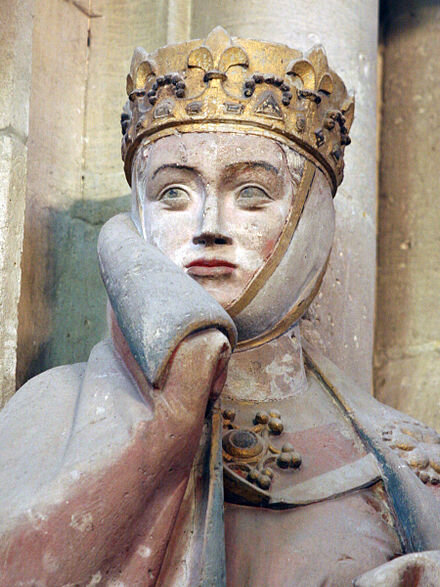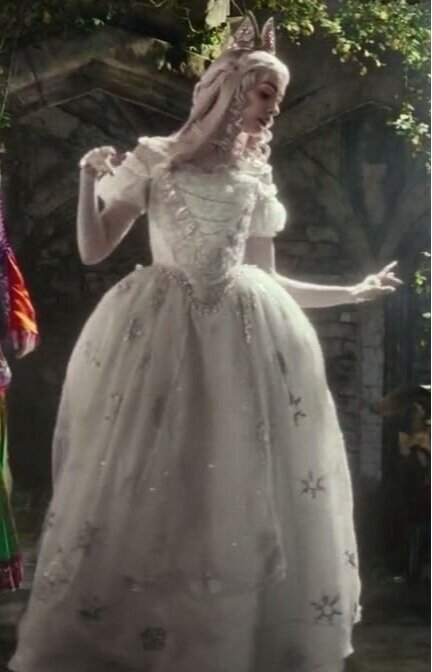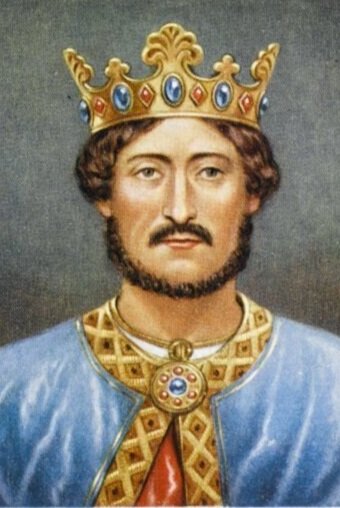Disney Crowns and Tiaras: Historical and Modern Inspirations (Part I)
Related Blog Posts:
Disney Crowns and Tiaras: Historical and Modern Inspirations (Part I) - Snow White, Alice in Wonderland (cartoon and live), Sleeping Beauty/Maleficent, Robin Hood, and the Great Mouse Detective
Disney Crowns and Tiaras: Historical and Modern Inspirations (Part II): Cinderella, Little Mermaid, The Princess and the Frog, and The Sword in the Stone!
Diadems, Tiaras, and Crowns, Oh My! - an overview of types, definitions, and purposes
The Classic Disney Influences in the Costumes of "The Descendants”
I’m going through all the crowns and tiaras shown in Disney animated films, analyzing their historical inspirations, and comparing them to actual crowns and tiaras worn by royals around the world! I’m not definitively saying that these original crowns/tiaras WERE inspirations for those in the films, but am just looking for similarities. There are so many though, that I’m just going to try to talk about 5 or so in each post.
Today, I’m going to look at crowns and tiaras in Snow White and the Seven Dwarfs, the various Alice in Wonderland films, the various Sleeping Beauty/Maleficent films, Robin Hood, and the Great Mouse Detective.
(L to R): Evil Queen , “Snow White and the Seven Dwarfs” - 1937; Uta von Ballenstedt statue - ~1044; She Who Must be Obeyed, “She” - 1935; and Princess Kriemhild, “Die Nibelungen” - 1924.
Evil Queen (Snow White and the Seven Dwarfs, 1937) - Only one character in the first full-length Disney animated film wears a crown: The Evil Queen. She sports a spiky gold “open” crown, with only a single pearl at the top. Keep an eye out for this style of crown, because we’ll see variations on it many more times in other Disney movies.
The queen’s look was mostly inspired by a statue of Uta von Ballenstedt at the Naumburg Cathedral in Naumburg, Germany. Uta was supposedly the most beautiful woman in medieval Germany. Many elements of the queen’s costume, including her headcovering, high cape, facial expression, and large pendant necklace are drawn from this. The character known as She Who Must Be Obeyed in the 1935 film “She” also is a likely inspiration for Snow White’s queen. Her crown, however, though gold like Uta’s and tall like the character in “She,” looks to be more inspired by Princess Kriemhild in the 1924 silent film “Die Nibelungen.”
I only found one actual royal crown with large spikes on it- the Danish king Christian IV’s coronation crown, made in ~1595 (below left, on the top). It does look pretty similar to the Eastern crown (also known as the Antique crown) in heraldry, except for the taller central front spike and the pearl at the top (below left, on the bottom).
It does have some similarities to the Diamond Festoon Necklace Tiara as well! (below center)
The Evil Queen’s tiara is much simpler than any of these real crowns and appears to be just solid gold, with only a single pearl on the top. Although the crown was probably designed this way to make the animation easier, historically, relatively simple gem-less metal tiaras became popular in the mid-1700s and through to the Victorian age. These cut steel tiaras were a less expensive way for women to obtain sparkly jewelry when they couldn’t afford diamonds or other precious gems. These were still time-consuming and beautiful though, as they were specifically cut and carved to shimmer as a diamond would. You can see an example below right.


Dutch Diamond Festoon Necklace Tiara - 1889
Swedish Cut Steel Bandeau - ~early 1800s
(Credit: Pascal Le Segretain / Wireimage)
Notes:
Quick Reminder:
Crown – A full circle headpiece with an emblematic function associated with sovereignty and nobility.
Tiara – An open semi-circular headpiece that usually does not encircle the head, but perches on the top. Worn by royal and noble women at white tie events, formal state occasions, and weddings.
Open crowns, without bands overhead, are the oldest crowns and leave the wearer’s head open to the sky. The vast majority of crowns in Disney animated films appear to be open. However, historically, closed crowns became the dominant design in sovereignty headgear in the middle ages and are the dominant type today.
Although the Evil Queen wears her crown throughout the movie (except when she’s disguised as an old woman), in real life, crowns would only be worn on special occasions, such as at coronations or upon other state occasions.
L to R: Queen of Hearts, “Alice in Wonderland” film - 1951; The Queen of Hearts, “Alice in Wonderland” book - 1865 (John Tenniel); Red Queen, “Alice in Wonderland” film - 2010; The Red Queen, “Through the Looking Glass” book -1871 (John Tenniel); and Elizabeth I - 1585 (portrait by Nicholas Hilliard).
L to R: The White Queen, “Alice in Wonderland” film - 2010; The White Queen, “Alice Through the Looking Glass” film - 2016; The White Queen, “Through the Looking Glass” book - 1871 (John Tenniel); and Elizabeth I, coronation portrait - 1559 (unknown artist).
Swedish Ducal Coronet
The Queen of Hearts/Red Queen; The White Queen - All of the Queens in the Alice in Wonderland (both animated and live action) movies wear spiky crowns that are relatively small and sit on top of their head instead of encircling them. This reminds me a bit of a Swedish ducal coronet (right).
In the book “Alice in Wonderland” (1865), the Queen of Hearts is drawn as a playing card character and sports a gable hood rather than a crown. She’s actually a totally different character from the Red Queen, who appears along with the White Queen in the book “Through the Looking-Glass” (1871), but the characters are commonly confused or melded together like in the live-action film series. The red and white queen characters in the books are clearly based off of chess pieces, which explains the continued spiky crown theme.
What’s interesting is that both characters in the live action films have some similarities to Elizabeth I at different times in her life. The Red Queen’s red hair, the shape of her updo, and her use of white makeup all over her face is clearly based off of Elizabeth I’s later looks. However, the white queen’s pallor and long flowing locks have some similarities to the young Elizabeth I’s look at her coronation. Both queens’ costumes have some Tudor elements to them, but neither crown looks like the Tudor crown (shown in Elizabeth’s coronation portrait), apart from the general “perched on top of head” appearance.
Notes:
Coronet – Small crown generally worn by dukes and earls at coronations, and often worn by princes/princesses at formal events. These are standardized for various peers, with different designs for each rank (e.g., Duke, Marquess, Earl, Viscount, Baron).
L to R: King Stefan and Queen Leah, “Sleeping Beauty” - 1959; Crown of Scotland (sans cap); King Stefan, “Maleficent” - 2014; Queen Leila, “Maleficent” - 2014; Stéphanie de Beauharnais, Grand Duchess of Baden's pearl-and-diamond tiara - 1830.
King Stefan (1959) and Queen Leah (1959) - Both of these crowns resemble the crown of Scotland without its velvet cap, minus the top arches.
King Stefan (2014) - This crown is very similar to the Swedish Ducal Coronet I talked about previously under the Red Queen/White Queen section, only larger, fitting around his entire head instead of perching on top like with the Alice Queens.
Queen Leila (2014) The shape of her crown reminds me of the pearl-and-diamond tiara of Stéphanie de Beauharnais, Grand Duchess of Baden, made circa 1830.
L to R: Princess Aurora, “Sleeping Beauty” -1959; the Braganza Tiara - 1829, Queen Rania’s diamond tiara (Credit: Tim Graham Picture Library / Getty), King Hubert, “Sleeping Beauty” - 1959; and the crown of Boleslaw I the Brave (replica made in 2001-2003 after originals were lost after 1036 and 1794).
Aurora (1959) - I couldn’t find any plain gold tiaras in this shape, but I did find a few modern silver and diamond that resemble it, such as the Braganza Tiara and Queen Rania’s Diamond Tiara.
King Hubert - I haven’t seen many crowns like this that don’t have arches but DO have a cap, but I DID find this one from the Polish crown jewels, which has arches but they’re so low to the cap that you can only see them from certain angles - The Crown of Bolesław I the Brave, which was the coronation crown of the Polish monarchs.
Queen Ingrith, “Maleficent: Mistress of All Evil” - 2019
L to R: King John and Queen Ingrith, “Maleficent: Mistress of All Evil” - 2019; George IV State Diadem -1820 (Credit: Royal Collection Trust); Aurora, “Maleficent: Mistress of All Evil” - 2019; Danish Ruby Parure Tiara ; Queen Ingrith, “Maleficent: Mistress of All Evil” - 2019; and the Spencer Honeysuckle Tiara - ~1858 .
King John and Queen Ingrith’s crowns both resemble the George IV State Diadem in their shape, color, and overall sparkliness.
Aurora’s gold vine crown bears a resemblance to the Danish ruby parure tiara.
Queen Ingrith’s silver tiara looks like the Spencer Honeysuckle Tiara in height and overall shape.
Queen Ingrith’s tall, thin tiara shares a lot in common with the tall small crowns worn by the red and white queens in Alice in Wonderland (as discussed earlier).
I’ve actually never seen Maleficent: Mistress of Evil, and now I really want to, if only to figure out why Queen Ingrith gets to wear three different crowns throughout it all!
L to R: Prince John, “Robin Hood” - 1973; King John of England’s tomb effigy; portrait of King John; King Richard, “Robin Hood” - 1973; Richard I’s tomb effigy; and Richard I .
Since the stories of Robin Hood include the historical figures Prince John (later King John I) and King Richard I as characters, we can actually look at portraits of them to see how similar the film’s crowns are to their historical counterparts’ crowns. Richard, of course, was known as Richard the Lion-Heart, so both he and Prince John are portrayed as lions.
The crown in Robin Hood appears to be a simplified form of the medieval crown used by King John and Richard I, as seen in their tomb effigies and portraits above. The animated and historical versions all appear to be gold, open crowns with alternating colors and sizes of gemstones, although the animated version has a much more simplified crenelation decoration than the fleur-des-lys/cross like decorations on the historical ones.
I’m fairly sure that the crown or crowns depicted (they LOOK awfully similar, don’t they?) are wearing their state crowns, the “working” crowns of monarchs that they wore regularly, rather than the coronation regalia, which was generally far older, heavier, and more valuable. Although the crown of St. Edward, the traditional coronation regalia for English kings, existed at the time of their reigns, Edward the Confessor wasn’t actually made a saint until 1161, and we don’t actually have any records that his crown was used again before Henry III’s in 1220. Both King Richard and King John reigned before than, from 1189-1199 and 1199-1216 respectively, so it seems likely that they were using different crowns. In addition, written records describing St. Edward’s crown describe it as having arches, while the crown seen in these effigies and paintings is clearly open and without arches.
The Mouse Queen, “The Great Mouse Detective” - 1986; Queen Victoria - 1882 (photographer Alexander Bassano); Queen Victoria’s small diamond crown - 1870 (Credit: Royal Collection Trust); and the Imperial State Crown - 1932 (Credit: Royal Collection Trust).
The mouse queen in “The Great Mouse Detective” is clearly an homage to Queen Victoria, as the character appears to have a similar age, shape, and dress to the real life Victoria. Her small crown worn over a veil is the biggest giveaway, as Victoria herself wore such a miniature crown over her widow’s cap following the death of her husband Prince Albert. After Albert died in 1861, the Queen withdrew from public life. Though she eventually came back into the public view in 1870, she refused to wear the imperial state crown again, partly due to its weight and partly because she could not have worn it over her widow’s cap. The miniature imperial crown was created as a substitute. Victoria continued to wear black and white “widow’s weeds” until he death in 1901.
The mouse queen’s crown does appear to have a velvet cap and at least one gemstone in the base that aren’t visible in Victoria’s crown. Though I haven’t seen a crown /exactly/ like the mouse queen’s, it does appear to borrow some inspiration from the Imperial State Crown of the UK, which has a similar velvet cap and prominent gemstone in its base.
That’s it for now! I have many many many more crowns and tiaras to talk about in the future. :) These posts are very fun but oh man, they take a long time. Thanks for reading everyone!











































